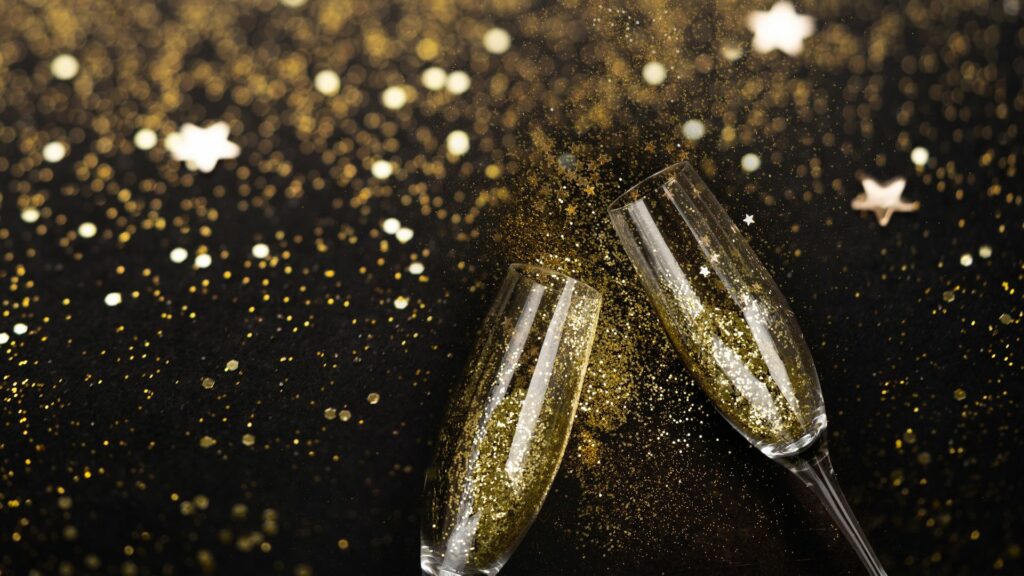DiVino may earn commissions from qualifying purchases.
Bubbly is synonymous with special occasions: New Years’ Eve parties, engagements and weddings, housewarmings, graduations and general good news. Even in our under-21 days, sparkling apple cider was a frequent stand-in at high school proms. So when did sparkling wine become the emblem of festivity?
A Brief History of Bubbly
What we know of as Champagne today, or more technically, the Méthode Champenoise (the Champagne Method) is one of history’s happy accidents, like chocolate chip cookies and tarte tatin.
For centuries, Burgundy was the most highly prized wine in France, but the winemakers of Champagne, just north of Burgundy were eager to get their name in the game. Unfortunately (or fortunately) nature got in the way. When temperature dropped early in the season, fermentation in the cellars came to a halt, leaving still-intact yeast cells inside the wine bottle. With the warm and sunny spring, the yeast came back to life with vigor, and with alcoholic fermentation comes carbon dioxide, and bottles started to blow from the pressure.
Watch a video about sparkling wine.
Believe it or not, back in the 17th Century, Benedictine monk, Dom Pérignon actually worked on how to reduce effervescence in the wines. At the same time he studied ideal grape varieties and pruning and techniques to extract more elegant flavors. He also encouraged the use of red grapes (primarily Pinot Noir), with a short press on the skins to add complexity to the wine.
Learn how sparkling wine is made.
Blame the British for the Bubbly Craze
Faithful fans of the wines of Champagne, when bottles arrived on English shores and began their re-fermentation process in warmer weather, the fizz was met with fanfare, and soon became known as a desirable trait. In 1662, the English scientist Christopher Merret cracked the code on what exactly was happening inside the bottles, and determined that the addition of sugar prior to bottling to could produce a build-up of carbon dioxide pressure in just about any bottle.
How to Keep Champagne Bottles from Exploding
The English loved their bubbly french wines so much, they even developed stronger, thicker glass bottles to withstand the pressure. Nowadays most sparkling wine bottles are built to last, but try not to shake things up too much, and definitely don’t leave your bottles in the freezer for too long.
Read more on how chill sparkling wine.
Champagne Charms the Royal Courts of Europe and Beyond
Not be outdone by the British, the French, starting with Philippe II, Duke of Orléans, who served the sparkling wine at his nightly feasts, assumed the trend. By the mid-18th Century, Paris was abuzz with bubbly, and the Champagne growers began to focus for heavily on the production of fizzy wine.
European royalty picked up on the trend as well. Champagne traveled with soldiers during the Napoleonic Wars, courtesy of Champagne merchant Charles-Henri Heidsieck, who was prepared to make sweeping sales regardless of the victors. This is very likely the advent of Champagne’s status as a celebratory beverage. Napoleon himself famously declared “Champagne! In victory one deserves it, in defeat one needs it.”
“Champagne! In victory one deserves it, in defeat one needs it.”
Napoleon Bonaparte
Champagne ended up in the happy hands of Prussian Kings, the Russian Tsar, the Royal Prince of Sweden and Norway, and as far as the royal courts of China and Siam (now modern Thailand). When the Russians occupied France, they ransacked Champagne cellars as tribute (who could blame them?) and later became one of Champagne’s largest markets.
Why Are Ships Christened with Champagne?
The use of Champagne as a token of battle victory may explain why ships are often christened by breaking a bottle of bubbly before departing the harbor. The tradition was first recorded in the late 19th Century, most notably with Queen Victoria’s christening of the HMS Royal Arthur. Superstition holds that the bottle must break for good luck, whereas an intact bottle bodes poorly for the crew.
This ritual likely explains why athletes and race car drivers pour Champagne on themselves, and even recreational boat purchases are christened with a splash of Champagne, something similarly sparkling.
Why is Champagne or Sparkling Wine Lucky?
During the 19th century, the idea of Champagne as symbol of prestige trickled down to American and British high society as well, cementing the bubbly beverage as something reserved for the rich and for splurge-worthy events. Birthday parties and anniversaries and retirement parties all call for something special, so sparkling wine it is.
Browse Champagne gifts for your next occasion.
When did Champagne Become a Party Drink?
As a symbol of good luck, sparkling wine makes perfect sense at engagements, weddings, New Year’s Eve, and graduations that celebrate a prosperous future. The idea of Champagne as a luxury lends itself to commemoration.
Shine Bright like a Diamond: The Glimmer of the Shimmer
Could it it also have something to do with Champagne’s diamond-like shimmer? Maybe. Modern pop culture teaches us that everything from jewel-encrusted gold and high fashion labels to precious bottles of wine and spirits-think Louis Roederer’s premiere Champagne Cristàl and Hennessy VS Cognac-become symbols of success and the highlife.
Regardless of the reason, do we really need an excuse to pop a bottle of Prosecco, Cava, Crémant, or Champagne? As Lily Bollinger, (1899-1977), ofBollinger Champagne said,
“I drink Champagne when I’m happy and when I’m sad. Sometimes I drink it when I’m alone. When I have company I consider it obligatory. I trifle with it if I’m not hungry and drink it when I am. Otherwise, I never touch it―unless I’m thirsty.”



